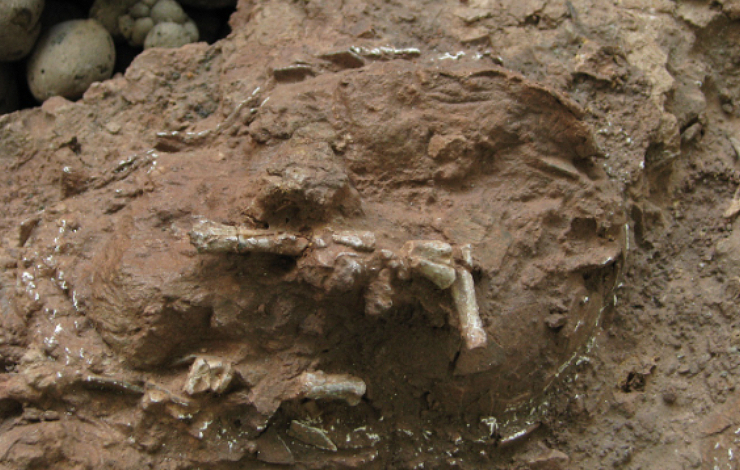14-06-2024

PHOTO: GAEL/NOVA
A "nest" with more than 80 dinosaur eggs reveals how large Jurassic carnivores built their nests and how natural disasters destroyed them. Discovered in the 1990s, the eggs with embryos from Paimogo are among Portugal's most emblematic fossils. The study uses techniques from mineralogy, tectonics, sedimentology, geochemistry, and paleontology to characterize this spectacular fossil.
A multidisciplinary team from universities in Portugal and Spain has studied one of Portugal's most emblematic fossils, revealing how dinosaurs nested 152 million years ago. The "Paimogo nest" is an accumulation of nearly a hundred eggs from allosauroid theropod dinosaurs, probably belonging to the species Lourinhanosaurus. Some of these eggs contain some of the oldest theropod dinosaur embryos in the world. Discovered
and described in the 1990s by amateur paleontologists Isabel and Horácio Mateus, this is one of Portugal's most iconic fossils, to the point that a commemorative 5-euro coin was recently minted in its honor.
The new research, led by Lope Ezquerro and directed by Miguel Moreno Azanza, former members of NOVA FCT and now professors of stratigraphy at Complutense University of Madrid and paleontology at the University of Zaragoza, aims to answer whether a single female could have produced
nearly a hundred eggs. Given the characteristics of the specimen, formed by a disordered accumulation without apparent nesting structures, the team approached the study with a distinctly multidisciplinary focus, conducting sedimentological, paleontological, geochemical, and paleomagnetic studies to delve into the processes that led to the formation of this unique fossil.
Paleontological and geochemical evidence suggests that the accumulation includes eggs from at least two different females, although it has been impossible to determine if the eggs were laid simultaneously or in successive nesting seasons. On the other hand, sedimentological and paleomagnetic studies concluded that the eggs were transported and accumulated by a flood caused by the overflow of a nearby river, which destroyed several clutches from different origins and transported them, accumulating them in a nearby area where the eggs were trapped among the vegetation. This process led to the death of several unborn offspring, resulting in the fossilized embryos, unique in the world.
The work has implications for the nesting strategies of this group of carnivorous dinosaurs, including the famous Allosaurus. The reconstruction of this accumulation suggests that allosauroids nested in mounds of earth or plants built on the ground, similar to some birds and other more modern theropods, rather than in dug-out holes like other dinosaurs.
The main contribution of this Portuguese-Spanish collaboration is that it sets a precedent for how potential dinosaur nests should be analyzed to confirm their identity. It is the first time that paleontologists, sedimentologists, geochemists, and geophysicists have worked together to better understand a possible nesting structure, opening the door to reinterpret accumulations of dinosaur eggs worldwide.
The Paimogo eggs can be visited at the exhibition of the Lourinhã Museum, within the “Parque dos Dinossauros da Lourinhã” the largest extinct fauna theme park in the peninsula. Additionally, a small exhibition dedicated to the results of this research can be visited at the headquarters of the new Oeste Geopark, in the Portuguese municipality of Bombarral. This new study confirms that the Iberian Peninsula is one of the richest places in the world for dinosaur eggs, with unique sites such as the Portuguese Jurassic, joining mega sites of dinosaur eggs from the late Cretaceous recovered in Catalonia, Castilla-La Mancha, and Aragón. Besides the Lourinhã Museum, this spectacular record can be visited at the Paleontological Museum of Castilla-La Mancha, in Cuenca, the Dinosfera center in Coll de Nargó, Lleida, and the Loarre Paleontological Laboratory in Huesca, where the authors of this study currently collaborate.
The study was conducted by a team from Nova University Lisbon, in collaboration with the universities of Aveiro and Zaragoza. The research was carried out over four years and funded by the Portuguese Foundation for Science and Technology through the projects XTalEggs and GeoBIoSauria (PTDC/CTA-PAL/31656/2017 and PTDC/CTA- PAL/2217/2021) and the GeoBioTec R&D unit.
You can read the scientific paper here.
Press
Paleontólogos portugueses e espanhóis estudam processos de reprodução no “Ninho de Paimogo”, RCL 99fm